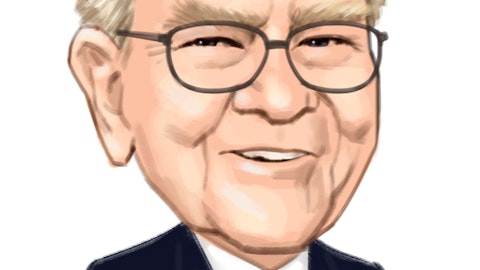The Procter & Gamble Company (NYSE:PG) Q1 2024 Earnings Call Transcript October 18, 2023
The Procter & Gamble Company beats earnings expectations. Reported EPS is $1.83, expectations were $1.71.
Operator: Good morning, and welcome to Procter & Gamble’s quarter-end conference call. Today’s event is being recorded for replay. This discussion will include a number of forward-looking statements. If you will refer to P&G’s most recent 10-K, 10-Q, and 8-K reports, you will see a discussion of factors that could cause the company’s actual results to differ materially from these projections. As required by Regulation G, Procter & Gamble needs to make you aware that during the discussion, the company will make a number of references to non-GAAP and other financial measures. Procter & Gamble believes these measures provide investors with useful perspective on underlying business trends and has posted on its Investor Relations website www.pginvestor.com a full reconciliation of non-GAAP financial measures. Now, I will turn the call over to P&G’s Chief Financial Officer, Andre Schulten.
Andre Schulten: Good morning, everyone. Joining me on the call today is John Chevalier, Senior Vice President, Investor Relations. This fiscal year, Jon Moeller, Chairman, President and CEO, will join the mid-year and year-end calls and I’ll be leading the Q1 and Q3 calls. Execution of our integrated strategy draws strong results in the July to September quarter. Broad-based organic sales growth across categories and regions, global aggregate market share growth, strong productivity savings enabling increased investment in superiority of our brands while also delivering very strong earnings growth. These strong first quarter results put us on track to deliver towards the higher end of our fiscal year guidance ranges for organic sales growth and core earnings per share, and continued strong cash productivity and cash return to share owners.
So moving to first quarter numbers, organic sales grew 7%. Pricing added 7 points to sales growth, and mixed contributed 1 point. Volume rounded down to a decline of 1 point with overall modest volume growth outside greater China. Top-line growth was broad-based across business units with each of our 10 product categories growing organic sales. Home care grew low teens, personal healthcare was up double digits, feminine care, oral care, fabric care, hair care and grooming, each grew high single digits. Baby care and family care were up mid-singles, skin and personal care grew low singles. Growth was also broad-based across geographies, with five of seven regions growing organic sales. Focus markets grew 6% for the quarter, organic sales in the US were up 7% and Europe focus markets were up 15%.
Greater China organic sales were down 6% versus prior year. Underlying market growth is soft and choppy as consumer confidence remains weak. SK-II was down low teens in Greater China due to soft market conditions and a temporary reduction in social retail merchandising. Enterprise markets were up 13%, with Latin America up 19%, and Europe enterprise markets up 15%. Shipment volume in the US grew 3% again this quarter and we returned to volume growth in Europe focus markets. Mexico, Brazil and India, some of our largest enterprise markets, continue to deliver volume growth. These gains largely offset volume declines in the Greater China, Asia Pacific and European enterprise regions primarily driven by underlying market contraction. Global aggregate value share was up 40 basis points versus prior year, with 32 of our top 50 category country combinations holding or growing share.
In the US, all outlet value share was up 50 basis points versus prior year with seven of 10 categories holding or growing value share in the quarter. US volume share was up 60 basis points, reflecting 3% volume growth. Value share in European focus markets was up 40 basis points over the past three months. Moving to the bottom line, core earnings per share were $1.83, up 17% versus prior year. On a currency-neutral basis, core EPS increased 21%. Core operating margin increased 240 basis points, as 460 basis points of gross margin expansion were partially offset by increased marketing investments, wage and benefit inflation, and foreign exchange impacts on SG&A. Currency-neutral core operating margin increased 340 basis points. Productivity improvements were a 210 basis point help to the quarter.
Adjusted free cash for productivity was 97%. We returned $3.8 billion of cash to share owners, approximately $2.3 billion in dividends, and $1.5 billion in share repurchase. In summary, against what continues to be a challenging and volatile operating environment, a very good start to the fiscal year across top-line, bottom line, and cash. Our team continues to operate with excellence, executing the integrated strategy that has enabled strong results over the past five years, and that is the foundation for balanced growth and value creation. A portfolio of daily use products, many providing cleaning, health, and hygiene benefits in categories where performance plays a significant role in brand choice. Ongoing commitment to and investment in irresistible superiority across the five vectors of product, package, brand communication, retail execution, and value across each price tier we compete.

A happy couple viewing the products of this household and personal product company in a mass merchandiser store.
We are again raising the bar on our superiority standards to reflect the dynamic nature of this strategy. Productivity improvement in all areas of our operations to fund investments in superiority, offset cost and currency challenges, expand margins and deliver strong cash generation. An approach of constructive disruption, a willingness to change, adapt, and create new trends and technologies that will shape our industry for the future, especially important in the volatile environment we’re in. Finally an organization that is more empowered, agile, and accountable. We continue to improve the execution of the integrated strategy with four focus areas, supply chain 3.0, digital acumen, environmental sustainability, and the employee value equation.
These are not new or separate strategies. They are necessary elements in continuing to build superiority, reduce costs to enable investment and value creation, and to further strengthen our organization. Our strategic choices on portfolio, superiority, productivity, constructive disruption and organization reinforce and build on each other. When executed well, they grow markets which in turn grow share, sales and profit. We continue to believe that the best path forward to deliver sustainable top and bottom-line growth is to double down on these integrated strategies, starting with a commitment to deliver irresistibly superior propositions to consumers and retail partners fueled by productivity. Moving to guidance. As I mentioned, we expect the environment around us to continue to be volatile and challenging from input costs, to currencies, to consumer and geopolitical dynamics.
We attempt to reflect these realities in our guidance ranges. Based on current spot prices, we estimate commodities will be a tailwind of around $800 million after tax in fiscal ‘24. This is consistent with the outlook we provided in July. However, within this estimate, there have been several moving parts. We’ve seen incremental relief on some commodities like pulp, which have been offset by higher costs than other commodities such as fuel. Foreign exchange rates have moved sharply against us, and we now expect a headwind of approximately $1 billion after tax, an incremental $600 million impact since our initial guidance for the year. In addition to these impacts, we are also facing higher inflation in wages and benefits, and we expect higher year-on-year net interest expense of approximately $200 million after tax.
As we are just one quarter into the fiscal year, we are maintaining our guidance ranges for organic sales, core EPS growth, cash productivity, and cash return to share owners, with each solidly on track after a very strong first quarter. Guidance for organic sales is growth of 4% to 5% for the fiscal year. The range includes a normalization in underlying market growth rate that is likely to occur through calendar year ‘24 as the market laps the last wave of cost recovery pricing and as market volumes return to growth. For P&G, we expect 3 to 4 points less pricing benefit in each of the next two quarters compared to our first quarter results. On the bottom line, our outlook for fiscal ‘24 core earnings per share is 6% to 9% growth versus last fiscal year.
We’re holding the range despite the incremental $600 million after-tax headwind from foreign exchange. With now a 7-point EPS impact from FX, this outlook translates to 13% to 16% core EPS growth on a constant-currency basis. We continue to forecast adjusted free cash flow productivity of 90%. We expect to pay more than $9 billion in dividends and to repurchase $5 billion to $6 billion in common stock, combined a plan to return $14 billion to $15 billion of cash to shareowners this fiscal year. This outlook is based on current market growth rate estimates, commodity prices, and foreign exchange rates. Significant additional currency weakness, commodity cost increases, geopolitical disruptions, or major production stoppages are not anticipated within the guidance ranges.
As you consider the cadence of earnings for the year, keep in mind that the back half of the year will see less pricing benefit as we progressively annualize prior year increases. We should also see less commodity benefit as we move through the year. Labor inflation continues throughout the supply chain and [in our] (ph) costs. FX headwinds will increase versus quarter one. Also with a strong start to the year, we’ll be reinvesting to further strengthen our plans and to maintain strong momentum. Finally, we’ll be closely watching the health of the China market and the balance of regions, energy costs are rising as we head into fall and winter, household saving levels have reduced, especially in Europe. Slower economic growth, higher energy costs and higher interest rates for longer have an impact on consumer confidence.
To conclude, while we expect volatile consumer and market dynamics to continue, we remain confident in our strategy and the results that it delivers. We are focused on driving growth in our categories and we are committed to delivering balanced top and bottom-line growth and value creation for our share owners. With that, we’ll be happy to take your questions.
See also 30 Best Luxury Hotels in Africa and 20 States with the Lowest Unemployment Rates.
Q&A Session
Follow Procter & Gamble Co (NYSE:PG)
Follow Procter & Gamble Co (NYSE:PG)
Operator: [Operator Instructions] Your first question comes from Steve Powers of Deutsche Bank. Please go ahead.
Steve Powers: Thanks. Good morning, Andre. I guess just picking up on your comments on organic growth over the balance of the year, maybe you could talk a little bit more about how you’re thinking about the progression of price versus volume versus mix over the remainder of the year. And then I’m curious as to whether your approach to balancing those various drivers differs at all between your focus markets, particularly the US and the enterprise markets where you’re experiencing more of the currency headwinds? Thank you.
Andre Schulten: Good morning, Steve. We — as we said in the prepared remarks, we expect the market to return to a lower, more sustainable growth rate more in line with historical growth at around 4%. That will have a stronger contribution on the volume side. We would expect that to be around 2% — 1% to 2% of pricing and maybe a point of mix impact. That will occur over the next few quarters and as always, P&G is intending to grow ahead of the market. So really, our expectation for the year is to be slightly ahead of the market in terms of volume and slightly ahead in terms of price. We continue to believe that we can price with strong innovation. And we have gained even more confidence over the past two years that our strategy of pricing with innovation to drive superiority and create value for the consumer is working.
And so we fully expect to return to that pattern. And again, pricing has been a core component of our growth for 18 out of the last 19 years, so we expect that to continue. Specifically, I think the pricing will start to lap in quarter two. So you will see probably the price contribution drop to — by 3 to 4 points in quarter two, and that was expected. And we then sequentially expect volumes to pick up and offset part of that but do expect a lower overall market growth rate for the balance of the year. To your second part of the question, enterprise markets versus focus markets, I think the only differential would be foreign exchange. And we’ll continue to price for foreign exchange. We’ve done that very successfully across the world. Turkey is a major example where we’ve been able to price for the significant devaluation of the Turkish lira, but we are able to grow share, grow sales, grow profit.
We’ll continue that model. Outside of that, we’ll continue to do and drive the same business model we’re driving in focus markets, innovate, drive superiority, price, grow markets and thereby grow sales, profit and share.
Operator: Next question comes from Dara Mohsenian of Morgan Stanley. Please go ahead.
Dara Mohsenian: Hey, good morning, guys. So just to follow up on that. Can you characterize what you’re seeing competitively in terms of the pricing environment? Obviously, it will be different by geography and product category. But in general, what type of behavior are you seeing from your competitors? And any thoughts around retailer pushback as commodities have turned favorable year-over-year? And just then in terms of volume growth, it sounds like we should expect a return to volume growth. Just what you think your level of visibility is around that and how much comfort you have and ultimately returning to volume growth as pricing drops off? Thanks.
Andre Schulten: Good morning, Dara. When you look at the total market, it’s very consistent with previous periods. You still see average market growth of around 6% to 7%. And you see still the price component being a significant driver. Volumes are stabilizing at a global level. Minus a point to flat, depending on the geography. You look at the only exception being Greater China. So the price component and the price rollover is consistent period-over-period. So no differentiation there from a competitive standpoint, at least not that we see it. Promotion continues to be — promotion levels and other indicator continue to be below pre-COVID levels. In the US, for example, volumes sold on deal is now at about 29%. Overall promotion level is still [indexed 80] (ph) versus pre-COVID.





